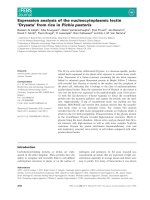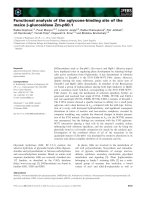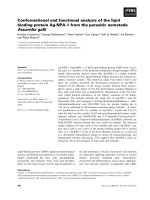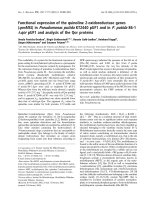Functional analysis of the nuage, a unique germline organelle, in drosophila melanogaster 7
Bạn đang xem bản rút gọn của tài liệu. Xem và tải ngay bản đầy đủ của tài liệu tại đây (1.85 MB, 7 trang )
92
cytoplasmic bodies is observed. Bars are 20 µm and 10 μm for egg chambers and nurse
cells, respectively.
3.3.3 piRNAs are localised to the GFP-labeled HeT-A bodies
AUB and AGO3 complexes are reported to associate with piRNAs in the germline
(Gunawardane et al., 2007; Nishida et al., 2007). In addition, recombinant AUB and
AGO3 are competent for cleaving a substrate RNA at a siRNA target site (Gunawardane
et al., 2007), indicating that these AGO proteins are potential constituents of germline
RISCs. In order to determine whether the nuage cytoplasmic foci consist of piRNA-
loaded germline RISCs, the presence and localisation of antisense piRNAs were
examined using FISH. The antisense HeT-A piRNA signals co-localised with the GFP-
HeT-A foci in the aub control ovary (green arrows, Figure 3.3.5a and a’), while an
irrelevant probe hybridising to antisense 2S rRNA or a piRNA-unrelated HeT-A antisense
region did not exhibit any significant co-localisation (Figure 3.3.5b and b’, and data not
shown). A control staining with secondary antibodies alone did not exhibit non-specific
labeling of the GFP-HeT-A foci (data not shown), further indicating the specificity of
HeT-A piRNA probe. In aub mutant where the production of piRNAs is impaired (Vagin
et al., 2006), the antisense HeT-A piRNA signal was undetectable (Figure 3.3.5c).
Similarly, specific antisense HeT-A piRNA signal was observed in the control but not in
krimp mutant ovary (Appendix VII). The localisation of both piRNAs and the target
transcripts to common foci that possibly contain the mRNA degradation proteins reflect
the assembly of a macro-RNP complex committed to the removal of retroelement
transcripts. To distinguish them from conventional P-bodies, these foci are termed as pi-
bodies.
93
Figure 3.3.5 Antisense piRNAs co-localise with GFP-HeT-A bodies. (a) FISH for
antisense HeT-A piRNAs in aub mutant. In the aub control ovary, antisense HeT-A
piRNAs co-localise with GFP-labeled HeT-A
mRNA
in the same cytoplasmic bodies
(green arrows in a’). (b and b’) FISH with the control probe against antisense 2S rRNA
does not co-localise with GFP-labeled HeT-A mRNA. (c) In aub mutant, antisense HeT-A
piRNA signal is undetectable. Bar is 10μm.
3.3.4 pi-body assembly is piRNA-dependent and correlates with retroelement
silencing
In spn-E and aub mutants where the production of piRNAs is compromised (Vagin et al.,
2006), no overlaps between cytoplasmic KRIMP foci and dDCP1/2, Me31B or PCM
were observed (Figure 3.3.4a and Figure 3.3.6), indicating that pi-body assembly is
disrupted. This observation suggests that cytoplasmic nuage proteins and the targeted
mRNAs are recruited to mRNA degradation components, or vice versa, in a piRNA-
dependent manner, forming pi-bodies that can contribute to retroelement silencing.
a a’
b b’
c
94
Figure 3.3.6 Assembly of the pi-bodies is piRNA-dependent. In the wild-type ovary,
mRNA degradation proteins dDCP1/2, Me31B, and PCM, overlap cytoplasmic KRIMP
foci. In contrast, in piRNA pathway mutants spn-E and aub, where the production of
piRNAs is compromised, cytoplasmic KRIMP foci no longer overlap with the mRNA
degradation proteins. Bar is 10 µm.
To exclude the possibility that the failure of pi-body assembly in spn-E and aub mutants
impairs the activities of mRNA degradation proteins and results in retroelement silencing,
two representative activities of mRNA turnover, namely deadenylation and decapping of
a non-retroelement transcript cycB, were examined. The rapid degradation of the cyc
95
transcripts has been shown to be regulated by deadenylation (Morris et al., 2004). To
monitor deadenylation activity, the length of the cycB poly(A) tail was examined in the
aub mutant using LM-PAT assay (Figure 3.3.7; Salles et al., 1999). In comparison to the
deadenylase mutant twin, where deadenylation was compromised and longer poly(A)
tails were observed, cycB transcript appeared to be efficiently deadenylated in the aub
mutant. This indicates that deadenylation is unaffected in at least one of the piRNA
pathway mutant aub.
Figure 3.3.7 Deadenylation is unaffected in aub mutant. LM-PAT assay of cycB. In
the piRNA pathway mutant aub, deadenylation appears unaffected since the poly(A) tail
length is comparable to that of the control. In contrast, deadenylation is impaired in the
deadenylase mutant twin, as indicated by the accumulation of longer poly(A) tails.
To examine decapping, total RNAs extracted from both control and aub mutant ovaries
were treated with Terminator™ 5’-phosphate-dependent exonuclease, and subjected to
96
RT-PCR for cycB. RNA molecules with 5’ cap structures are protected from the
exonuclease and therefore competent for amplification. Similar to the control, cycB
transcript was comparably degraded by the exonuclease in the aub mutant (Figure 3.3.8),
indicating that cycB mRNA is efficiently decapped.
Figure 3.3.8 Decapping is unaffected in aub mutant. Cap analysis of cycB. In aub
mutant as well as in the control, the 5’-UTR of cycB is efficiently degraded by
Terminator™ 5’-phosphate-dependent exonuclease, indicating that decapping of cycB
takes place normally. The control small-nuclear RNA U1, which harbours a 2,2,7-
trimethyl G-cap, is resistant to exonuclease treatment.
Consistent with the unaffected mRNA degradation activities in aub mutant, no
observable changes in the protein expression of four mRNA degradation proteins PCM,
SKI3, Me31B, and dDCP1 were detected in aub or krimp mutants (Figure 3.3.9). Taken
together, these data show that the retroelement silencing defect in the piRNA pathway
mutants is not due to impairment of the mRNA degradation machinery.
97
Figure 3.3.9 The protein expression of mRNA degradation proteins is unaffected in
piRNA pathway mutants. Western analyses of mRNA degradation protein expression in
the piRNA pathway mutants. Expression of DCP1, SKI3, PCM, and Me31B is unaffected
in aub and krimp mutants.
3.3.5 piRNA-mediated retroelement silencing is post-transcriptional
The localisation of the retroelement transcripts with the nuage/P-body foci suggests that
retroelement silencing is post-transcriptional. To determine if piRNA-mediated
retroelement silencing is post-transcriptional in vivo, retroelement decay was investigated
in aub control and mutant ovaries using the inducible HeT-A transgene harbouring ms2.
Following the induction of HeT-A ms2 mRNA by heat-shock, ovaries were dissected at
time intervals up to 12hr, and northern blotting was performed with a probe that
specifically detects exogenous HeT-A ms2. In the control ovary, HeT-A ms2 mRNA was
98
rapidly degraded and the level of transcript was undetectable by 100 min post-induction
(Figure 3.3.10). On the other hand, in the aub mutant, HeT-A mRNA exhibited prolonged
stabilisation (Figure 3.3.10) and remained detectable 2 to 3 days post-induction (data not
shown). This suggests that a prolonged post-transcriptional retroelement silencing is
dependent on piRNAs.
Figure 3.3.10 Post-transcriptional retroelement silencing is piRNA-dependent. (a)
Timecourse of HeT-A ms2 mRNA decay in the aub mutant. HeT-A ms2 expression is
induced by heat-shock and changes in mRNA abundance are measured over time. A rapid
initial degradation of HeT-A ms2 mRNA is observed in both control and aub mutant
ovaries. However, aub mutant exhibits prolonged stabilisation of the HeT-A MS2
transcript, while the exogenous mRNA is undetectable in control ovaries by 100 mpi. (b)
Graphical output of normalised HeT-A ms2 transcript against gadph mRNA in control
and aub mutant ovaries. Error bars indicate the standard deviation between the triplicates
of each sample.
n = 3.
The examination of endogenous retroelement transcripts also showed significant
accumulations of full-length HeT-A and I-element mRNAs in spn-E, aub, and krimp
mutants (Figure 3.3.11). In addition, a low level of full-length HeT-A transcript
a
b









